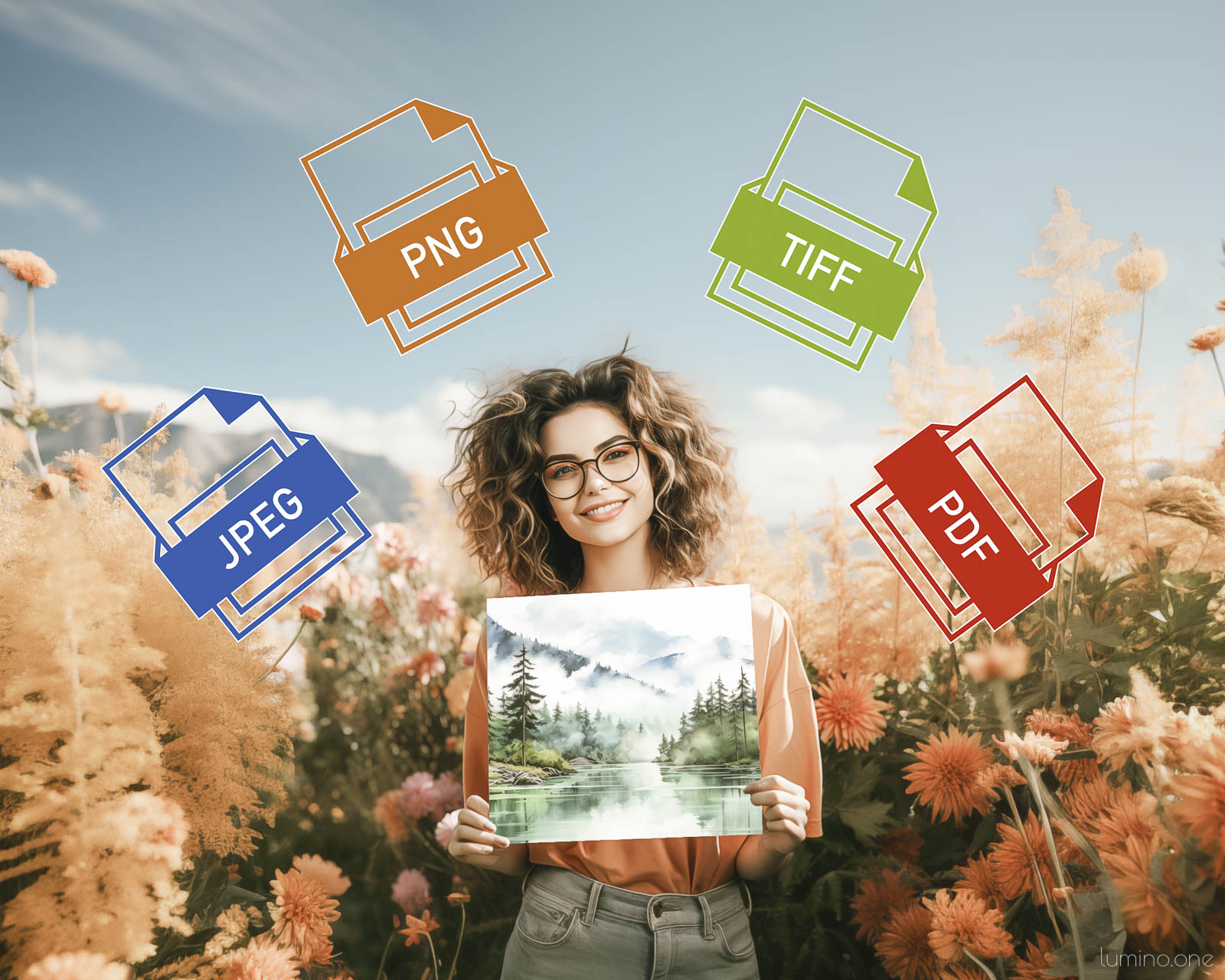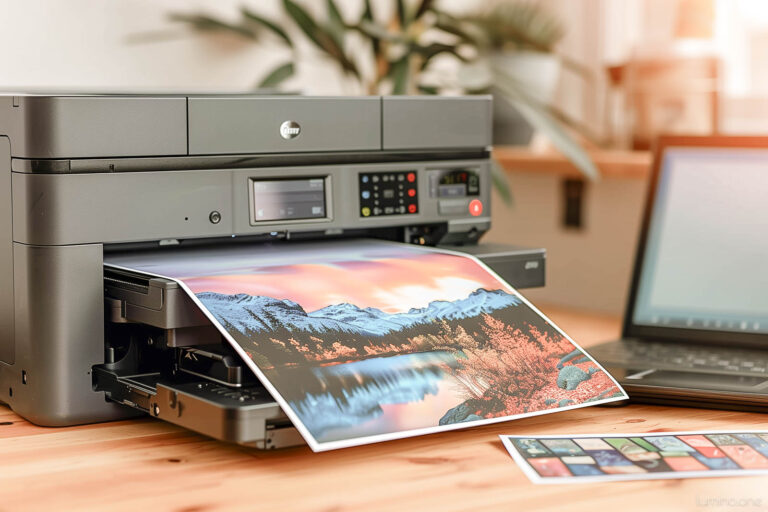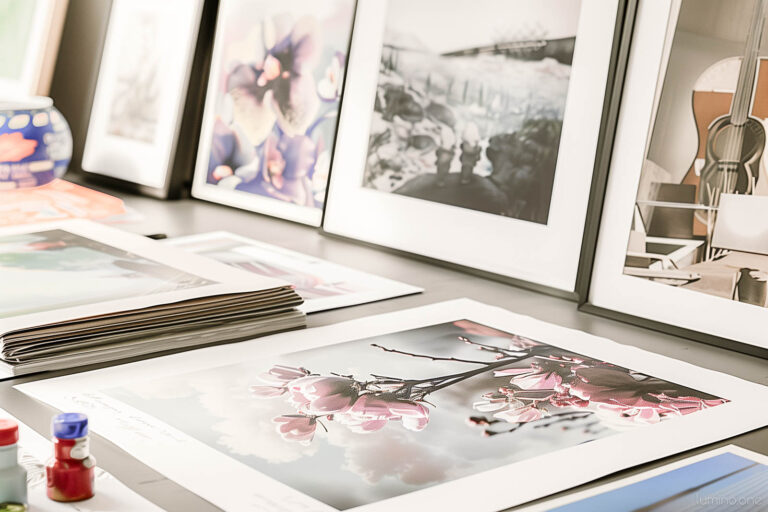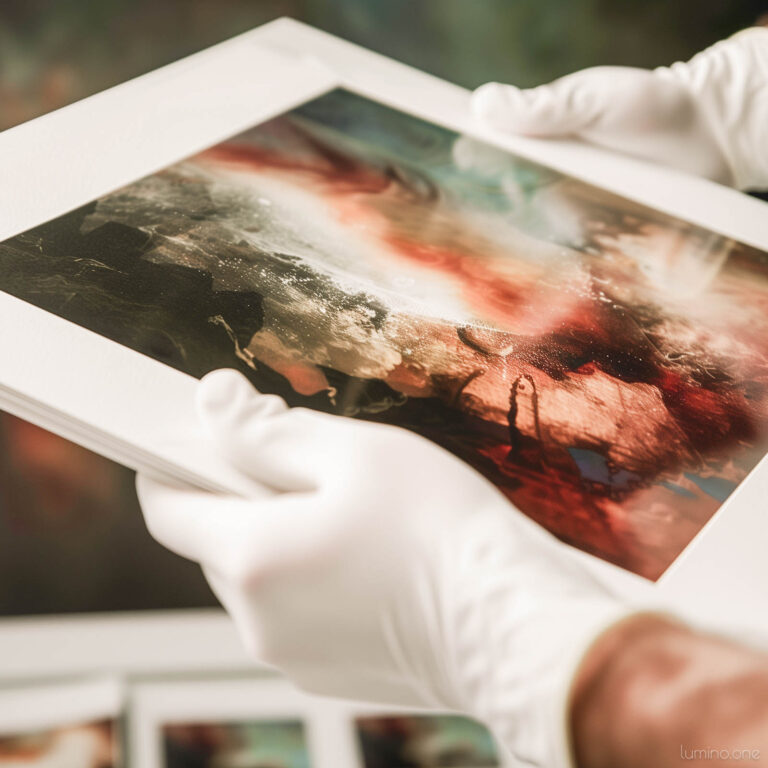Selecting the perfect file format for your digital art print can feel a bit like unlocking a secret level in a game—it’s that important step that can turn a good print into a great one. If you’re not the artist but have fallen in love with a digital piece, or perhaps you’ve just downloaded a stunning image you’re eager to see on your wall, understanding file formats is your key to a vibrant, striking display.
Not all file formats are created equal. Some excel at preserving crisp details and rich colors in large posters, while others might be better suited for smaller, framed prints. Plus, compatibility with your printer is crucial. Choose wrongly, and you might not just end up with a less-than-stellar print—you could also face technical snags that could have been easily avoided.
In this blog post, we’ll dive into the world of JPEGs, PNGs, TIFFs, and PDFs. I’ll help you navigate through their strengths and pitfalls in printing so that you can make an informed decision. Whether you’re decking out your living room or sprucing up your office, picking the right file format is essential for bringing your digital finds to life just as you imagine them.
TABLE OF CONTENTS:
Most Common File Formats for Digital Art

When you’re ready to bring your digital art from screen to paper, the file format you choose can make a huge difference. Let’s break down the main players: JPEG, PNG, TIFF, and PDF. Understanding these formats will help ensure that your digital masterpiece prints just as beautifully as you imagined.
- JPEG (Joint Photographic Experts Group)
- Use: Perfect for digital photos and standard web graphics.
- Why it works: JPEGs are all about efficiency. They keep file sizes small but can reduce quality through compression. Ideal for sharing online but think twice if fine detail is a must for print.
- File extension:
.jpegor.jpg
- PNG (Portable Network Graphics)
- Use: Great for web images that require transparency or high-quality visuals.
- Why it works: PNGs support a broader color range and better compression. They’re your go-to for sharp, detailed images, especially if you dislike the pixelation or blurring that can happen with JPEGs.
- File extension:
.png
- TIFF (Tagged Image File Format)
- Use: The professional’s choice for archiving and high-quality printing.
- Why it works: TIFFs preserve all image data with optional compression that doesn’t lose quality. They are larger in size but are the gold standard for any print where every detail counts.
- File extension:
.tiff
- PDF (Portable Document Format)
- Use: Universal for sharing documents that look the same everywhere.
- Why it works: PDFs are not just for texts; they excel in preserving the exact look and feel of your design, including colors and layouts, making them ideal for all forms of printing.
- File extension:
.pdf
Each of these formats has its strengths and scenarios where it shines. By picking the right one, you not only preserve the quality of your artwork but also enhance its presentation in print. Remember, the right file format is like the right frame for a painting: it showcases your work at its very best.
Detailed Comparison of File Formats for Art Printing

When it comes to printing your digital art, the file format you choose can make all the difference. Each format brings its own strengths to the table, suited for different types of artwork and printing needs. Let’s break down the options so you can find the perfect fit for your beautiful creations.
- JPEG vs. PNG
- Quality: JPEGs are typically used for their small file size which makes them great for sharing online, but this comes with a trade-off in quality due to lossy compression. On the other hand, PNGs offer lossless compression, ensuring that your images maintain their sharpness and detail, which is key for prints that demand high visual fidelity.
- File Size: JPEG files are smaller and more manageable for quick transfers or email. PNG files are larger, which might use more storage but keep your images looking crisp and clear.
- Compression Effects: While JPEG might introduce some artifacts or blur finer details after repeated saving, PNG holds up robustly, preserving the quality no matter how many times you save it.
- PNG vs. TIFF
- Quality: Both formats are stellar at preserving quality. TIFF is often the choice for professional photographers and publishers because of its non-compromised quality and ability to handle detailed and extensive image data.
- Support for Transparency: PNG is unique in its support for transparency, making it ideal for web graphics and overlay images that need to maintain a seamless look without a visible background.
- When to Use Each: Use TIFF for ultimate quality prints where every pixel counts, such as in fine art photography or detailed illustrations. PNG is best for online display and smaller prints where file size and background transparency are priorities.
- PNG vs. PDF
- Roles in Printing: PDFs are versatile in handling diverse document types — from text-heavy pages to image-rich files — and maintain layout and color integrity across different viewing and printing platforms. PNG is suited for cases where image quality above all else is desired.
- Handling of Resolution and Color Integrity: PDF ensures that what you see on your screen is what you get on paper, making it ideal for business and professional prints that require exact color matches and clear details.
- PDF vs. JPEG
- When to Use Which: Consider using PDF for art prints that involve complex layouts or when you need to ensure the print matches the artist’s vision exactly. JPEG might be sufficient for more casual uses, like quick prints for a family album or images that do not require precise color accuracy.
- Type of Artwork: Artworks that rely heavily on the exact reproduction of colors and details are better served by PDFs. JPEGs can be used for less detail-oriented work where ease of access and sharing are more important than print fidelity.
Choosing the right file format isn’t just a technical decision; it’s about bringing your digital art to life in the best possible way. Whether you’re preparing a gallery show or printing a new piece to hang in your living room, understanding these formats will help ensure that your artwork looks as stunning on paper as it does on your screen.
Best Practices for Printing Digital Art
Preparing your digital art for print is much like transforming a beloved recipe into a meal; it requires attention to detail and a bit of know-how to ensure everything turns out just right. Here’s a straightforward guide to getting your files print-ready, ensuring every piece comes out as vibrant and impressive as intended.
Formatting Art for Print
A well-prepared file can make all the difference in printing. Follow these steps to ensure your artwork is set up for success:
- Resolution is Key: Aim for a resolution of at least 300 dots per inch (DPI). This will keep your images sharp and detailed, avoiding any blurriness or pixelation.
- Not sure if your resolution is large enough? Check it in our free print size calculator.
- Mind the Color Profiles: Use the CMYK color profile for most prints. This profile is designed for printing and ensures that the colors you see on your screen are what you get on paper.
- Check Your File Size: While you want high resolution, be wary of file sizes that are too large, as they can be difficult to handle or process. Some online printing services have max size limitations. Optimize images to balance quality and size.
Maintaining Quality in Print
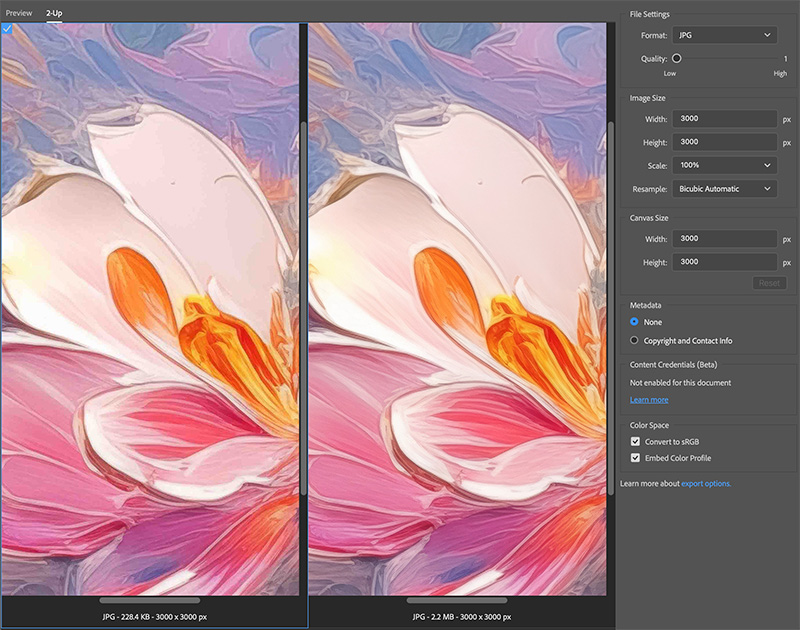
Ensuring your art prints flawlessly involves more than just selecting the right file format. Here are tips to maintain the highest quality:
- Test Print: Always run a test print on a smaller scale to check how the colors and details translate from screen to paper. This can help you catch any issues before the final print.
- Use Professional Services: When possible, use professional printing services. They have the expertise and equipment to handle detailed files and can offer advice on how to get the best results.
- Preview and Proofread: Always preview your files in the format you intend to print. Look for any last-minute adjustments in color, alignment, or layout that could enhance the final product.
- Select the Right Paper: The type of paper can dramatically affect how your print looks. Glossy papers are great for vibrant photos, while matte finishes are better for softer, more textured prints.
By following these guidelines, you’ll be better equipped to bring your digital creations to life with the same clarity, color, and detail you see on screen. Remember, every step from file preparation to the final print contributes to the masterpiece that will hang on the wall or find its place in a cherished album.
Confused about any of the tips mentioned? We’ve created a more thorough guide for printing digital art where we cover aspect ratios, sizes, paper choices, etc.
Digital Art Printing FAQs
Diving into the world of digital art printing brings its fair share of puzzles and myths. Let’s clarify a couple of common questions about using PNG files for print and what happens when you convert these files to PDF.
Can You Use PNG for Print?
Absolutely! PNG is a versatile file format, often praised for its clear, crisp quality in digital displays. Here’s when and how you can use PNG effectively for printing:
- When to Use PNG:
- Detail Matters: For prints where sharp detail and clarity are paramount, especially for artwork like digital illustrations or graphics.
- Need for Transparency: If your project involves layers or backgrounds that need to be transparent, PNG is your go-to format.
- Guidelines for Using PNG:
- Resolution Check: Ensure your PNG files are at a high resolution—300 DPI at least—to maintain quality in print.
- Size Considerations: Be aware that PNG files can get quite large. Make sure your printer can handle the file size without issues.
Does Converting PNG to PDF Lose Quality?
The thought of converting from PNG to PDF can raise concerns about quality loss. However, if done correctly, you can convert these files without sacrificing clarity:
- Quality Maintenance: Conversion does not inherently degrade image quality. PDF can encapsulate high-quality images just as well as PNG, especially if no compression options are applied during the conversion process.
- When to Convert:
- Document Assembly: Use PDF when you need to combine several images or include text alongside your images, as it’s excellent for creating comprehensive documents.
- Universal Compatibility: If you need a file format that is readily accessible and consistently viewable on any device, PDF is more standardized for sharing and printing across different platforms.
By understanding these nuances, you can make more informed decisions and use PNG and PDF to their fullest potential, ensuring your prints turn out just as vibrant and detailed as intended. Remember, the right file format can be the key to unlocking the true beauty of your artwork in its printed form.
Choosing the Right Format for Your Art Print Project
Picking the perfect file format for printing your digital art isn’t just a technical decision—it’s about bringing your vision to life with the highest fidelity. Whether you’re creating fine art prints, promotional materials, or personal projects, each file format offers unique benefits. Let’s navigate through the options to help you choose wisely based on your artwork’s needs.
Situations and Types of Artwork for Each Format
- JPEG:
- Best For: Casual prints, quick projects, or digital platforms where file size and faster loading are crucial.
- Artwork Types: Event photos, personal photo albums, or any project where slight quality loss is acceptable for the sake of compression.
- PNG:
- Best For: Artworks requiring transparency or where no quality loss is acceptable.
- Artwork Types: Web graphics, logos, and digital illustrations that rely on sharp details and clarity.
- TIFF:
- Best For: High-quality print productions where every detail matters.
- Artwork Types: Professional photography, fine art prints, and archival copies that require non-lossy compression.
- PDF:
- Best For: Comprehensive documents that combine text with images, or for printing across different systems while maintaining consistent layout and color.
- Artwork Types: Brochures, multi-page documents, or art prints that need exact reproduction for exhibitions or sales.
Decision-Making Tips for Choosing the Best File Format
- Consider the Type of Art:
- Detailed graphics and fine art demand formats like TIFF or PDF, which preserve every pixel in print.
- For everyday photos or web images, JPEG or PNG might suffice.
- Assess the Scale of the Print:
- Large-scale prints work best with TIFF or PDF due to their ability to handle high resolutions without losing quality.
- Smaller prints or online sharing are more flexible and can be served well by JPEG or PNG.
- Determine the Required Quality:
- If the print must be archival quality or for a gallery, lean towards TIFF.
- For less critical uses where ease and efficiency are valued, JPEG or PNG are adequate.
- Evaluate Your Printing Environment:
- Professional printers may prefer PDF or TIFF for their reliability and consistent results.
- Home printers and quick print services can generally handle JPEG or PNG without issues.
Choosing the right file format is like selecting the right tool for a job—it can greatly enhance the outcome. By understanding the strengths of each format and matching them to the specific needs of your project, you ensure your artwork is presented just as you envisioned, maintaining its integrity from digital screen to printed media.
Digital Art File Format Comparison Table
Here’s a detailed table that compares the characteristics of JPEG, PNG, TIFF, and PDF file formats, tailored for anyone looking to understand their best use in the context of printing digital art:
| File Format | Pros | Cons | Best Use Cases | Compression | File Size | Artwork Type | Print Size |
|---|---|---|---|---|---|---|---|
| JPEG | Small file size, widely supported | Loss of quality with high compression | Quick prints, web use | Lossy | Small | Casual photos, web graphics | Small to medium |
| PNG | Supports transparency, lossless | Larger file size than JPEG | Web graphics, digital art | Lossless | Medium to large | Digital illustrations, graphics with transparency | Small to large |
| TIFF | High quality, no loss of detail | Very large file size | Professional print jobs, archiving | Optional, lossless | Large | Professional photography, fine art prints | Large |
| Maintains layout and color, versatile | Can be complex to edit | Documents combining text and images | Lossless or lossy | Varies | Brochures, multi-page documents, art prints | Any size |
This table serves as a quick reference to gauge which file format might be best for specific types of digital art projects, considering factors like the nature of the artwork, the desired print size, and expected outcomes.
Conclusion
Choosing the right file format for printing your digital art is more than just a technical step—it’s an essential part of ensuring that your creative vision comes to life exactly as you’ve imagined. Whether you’re a professional artist preparing for an exhibition or a hobbyist looking to adorn your walls with personal creations, understanding the strengths and limitations of each file format can dramatically influence the quality and impact of your printed pieces.
Remember, JPEG is ideal for quick prints and everyday use, PNG shines when transparency and crisp details are needed, TIFF is unbeatable for professional quality and archival prints, and PDF offers unmatched versatility for document integrity across platforms. By matching the file format to the specific needs of your project, you ensure not only that your artwork is presented in its best light but also that it resonates with its intended audience in the most effective way possible.
So, take these insights, apply them to your next project, and watch as your digital art transforms seamlessly from pixels on a screen to vibrant prints that captivate and inspire. Whether you’re printing at home or with a professional service, the right file format is your key to unlocking the true potential of your artistic work. Happy printing!
We cover many more aspects of printing digital art on our blog.


